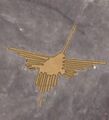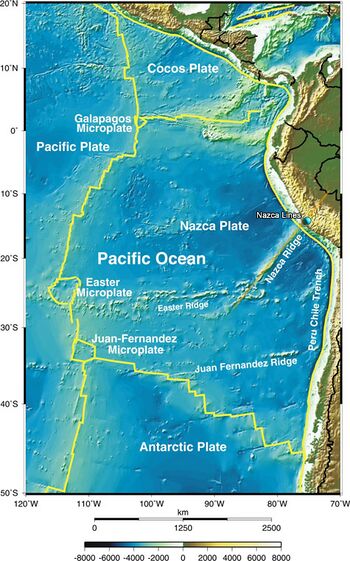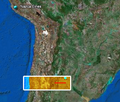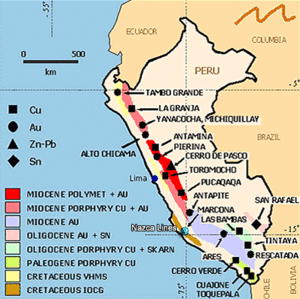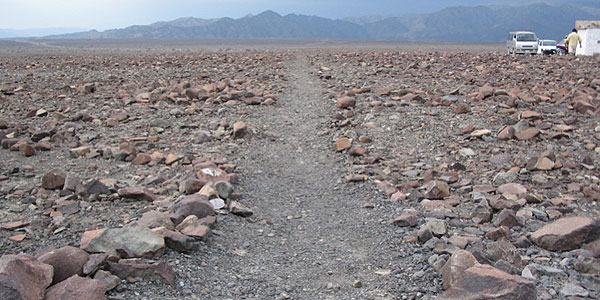Nazca Lines
Sommaire
- 1 A network to listen the wrath of the mountain Gods?
- 2 Arguments in favor of this theory
- 3 Electricity and Earthquakes
- 4 Geology
- 5 Archaeology
- 6 Mythology and beliefs in association with the geoglyphs
- 7 Conclusion?
- 8 References
A network to listen the wrath of the mountain Gods?
An electrosismic hypothesis

Michael Vaillant, May 2th, 2007
In this short article we are freely exploring the possibility of a relationship between Nazca Lines and electrosismic signals linked to earthquakes. The provocative question is:
"Does Nazcans developed an ancient network of antennas making possible the dectection of telluric [electric] potentials?"
In fact, the traces of Nazca actually observed could be the remains of emplacements where would have laid electric lines: transmission lines (conductors) made of gold and/or copper would have been stretched on the ground and used to collect telluric potentials. We imagine that it could be an image of the many tests which would have been conducted in order to find the "best" positions. These lines and figures were working as antennas thus used by priest to "listen the wrath of the mountain gods".
What are the Nazca Lines?
Discovered in 1926 the Nazca Lines are a collection of giant geoglyphs—designs or motifs etched into the ground—located in the Nazca Desert, a high arid platea coastal plain about 250 miles (400 kilometers) south of Lima, Peru. They were created by the Nazca culture between 200 BC and 700 AD. There are hundreds of individual figures, ranging in complexity from simple lines to stylized hummingbirds, spiders, monkeys, and lizards. Nazca Lines can only be fully appreciated when viewed from the air given their massive size. Despite being studied for over 80 years, the geoglyphs—which were designated a UNESCO World Heritage Site in 1994—are still a mystery to researchers.
The lines were made by fusing the iron oxide coated pebbles which cover the surface of the Nazca desert. When the gravel is removed, they contrast with the light-colored earth underneath. There are several hundred simple lines and geometric patterns on the Nazca plateau, as well as over seventy curvilinear animal, insect, and human figures. The area encompassing the lines is nearly 500 square kilometers (200 square miles), and the largest figures can be nearly 900 feet (270 meters) long. The lines persist due to the extremely dry, windless, and constant climate of the Nazca region: the Nazca desert is one of the driest on Earth and maintains a temperature around 25°C (77°F) year round, and the lack of wind has helped keep the lines uncovered to the present day.
For Giuseppe Orefici, (chief of the only archaeological mission authorized to work there), the three types different of geoglyphs (spiral - animals - lines or arrows) belong to quite different times: “towards 500 BC Nazcas initially represented spirals and the first figures of birds. Then they evolved to larger géoglyphes (representing birds - cat-like - orcs…) who constituted the Pantheon of their divinities. After this first period, they set up cities”.
But during the 4th Century, two natural disasters (an earthquake and a gigantic flood) shook their convictions and they buried of a ballasting the town of Cahuachi and left it. Is it why Nazca actually means ´´pain´´ in ancient language ? Then, they were then assimilated by Huaris, populates Andean.
The interpretation of Giuseppe Orefici is cultural and ethnic. Nazcas adored the mountains. The question is why these people venerate the animals and the mountain? In addition why would they have had this so radical reflex consisting in burying themselves their city under a ballasting following an earthquake? Have they been betrayed by the gods?
As there are three basic types of Nazca Lines: straight lines, geometric designs and pictorial representations, we are going to focus only on the third category: stylized creatures. The hypothesis discussed here is not intended to explain all the kind of figures, as many explanations must intersect.
Arguments in favor of this theory
Several arguments are found in conjunction and connect to support this theory:
Electricity
- E1. Form: A kind of figures buckle on themselves to form circuits,
- E2. Size: Geoglyphs must be large enough to generate electric potentials, features should have constituted dipoles of sufficient length to capture the sismques waves of Ultra-Low Frequency (ULF: 0.01-10 Hz),
- E3. Orientation: Figures are made of very long straight lines, aligned with geological structures, (to prove !)
- E4. Emplacement: Figures are exactly on the axis of the Nazca ridge and above the subduction zone, where Nazca plate dives beneath the South American plate,
- E5. Conductivity: Strong magnetite concentrations makes possible the propagation of electromagnetic waves until this site
Archaeology
- A1. Construction: To build the geoglyphs the stones were pushed aside of a narrow way which was then levelled. Probably because of the need to stretch out the conductors on the ground,
- A2. Metalworking: Nazcans were supected to overcome the art of copper smelting, and gold smelting too. There are strong presumptions on this point.
Geology
- G1. Ore ressources: This zone has great resources of copper and gold the biggest world known copper mine is near this place, more in the south, in Argentina.
- G2. Seismology: This is a very strong seismogenic zone
Semantic & Mythology
These geoglyphs may have the following roles:
- R1. Magic and rituelic: geoglyphs represent animals, symbol of life, and mountain-gods. Induced electricity becoming the magic principle which supports this life,
- R2. of Protection: the production of a tenous electric signal by the means of geoglyphs would have be used as an alarm, a few hours before an earthquake occurs. That could mean that this site was used to protect the life: as an oracle making possible a communication with "the gods of mountain". Such a worship indeed seems to have been identified: Johan Reinhard [1], who had detailed various ancient traditions, has argued convincingly that the Nazcans worshipped the mountains, according to which the mountain-gods took to the skies in the form of eagles or condors, figures found on the site.
Electricity and Earthquakes
Preamble: discovery of Electric Signals connected to seisms
In 1989, a team from Stanford University happened to be listening for low-frequency magnetic noise in the Santa Cruz Mountains south of San Francisco with a large coil. On September 12, they noticed an unusual signal with a period between 5 and 20 seconds, which was followed by a background noise increase October 5. On October 17, the background noise rose to a high level, and three hours later the magnitude 7.1 Loma Prieta earthquake hit, rocking the San Francisco Bay area. The earthquake was centered less than five miles from their measurement coil. Since then, one explanation after another for these noise increases have been eliminated, leaving open the possibility that they truly were earthquake precursors.
This fortuitous experiment was precursory of a new technique of detection and anticipation of the seisms: the listening of the Seismic Electric Signals (SES) with energies ranging from 10^-3 Hz to 10^8 Hz.
Sources of the Seismic Electric Signals (SES)
A lot of research is being done on mechanisms of generation. The currents produced by the seisms could have several causes:
- radioactive gas such as radon would be released in excess several days before a seism, creating electrical currents on the surface,
- the compression of in particular crystalline rocks (those rich in quartz), would generate piezoelectricity,
- pore pressure changes also cause a conductive fluid flow that causes a current and related magnetic field. it's an "electro-kinetic" effect.
- This last phenomenon is successfully used today to envisage a few years or a few months in advance the imminence of a volcanic eruption, such as for the Piton de la Fournaise at Reunion Island or the Merapi in Indonesia.
The produced electromagnetic waves have a frequency going of a few Hz with approximately 3 Khz. Beyond that, the waves are absorbed by the rock and at all events are largely attenuated before arriving on the surface.
Also, when the seismic area is deeply hidden under the ground, there is a weak possibility of being able to detect the electromagnetic waves having frequencies of more than 3KHz.
The waves can be detected on positions close to the surface of the ground and which sometimes can be distant seismic areas.
Experiences in progress
- Professors Varotsos, Alexopoulos and Nomicos, all three members of a group baptized “VAN” and based at the university of Athens, undertake experiments on the detection as of SES for the prediction of the seisms. They claim of being able to predict a seism magnitude 5 or more, from several hours (in the case of aftershocks) to two weeks after signal detection, it can be up to several weeks for repeated and prolonged signals.
- In the VAN method, one monitors continuously the geoelectric potential changes. At each station, several short dipoles with different lengths (50-200 m) in both EW and NS directions and a few long dipoles (2- 20 km) in appropriate directions are installed. These dipoles consist of wire and electrodes buried in the ground.
- Permanent electromagnetic ULF monitoring stations along the San Andreas Fault. Installed and maintained by UC Berkeley and Stanford University, Department of Geophysics (Darcy Karakelian, Simon L. Klemperer, George A. Thompson, Antony C. Fraser-Smith).
- See: results from electromagnetic monitoring of the Mw 5.1 SAn Juan Bautista, California Earthquake of 12 august 1998
- French specialists of the ionosphere, among which Michel Parrot, developed a named space mission Déméter (“Detection of Magnet-Magnetic Emissions Transmitted from Earthquake Regions”). This microphone-satellite in the course of exploitation does not have for the moment not brought of significant result.
- A Report from the RIKEN International Frontier Research Project on Earthquakes (IFREQ)
The great difficulty today is to be able to discriminate the artificial signals, emitted by the man, of the natural signals.
It should be noted that work on SES being recent (the Eighties) they remains discussed enough. Remainder, a member of the institute of Physique of the Earth of Paris pays:
“Them ITS remain nevertheless a subject of controversy. There are vague indices that the earthquakes could be preceded by precursory signs, in particular electric. On the other hand, there is not yet ANY convincing example, in spite of the most benevolent efforts. That remains an assumption, interesting, but an assumption that it is necessary to study seriously by experiments, after having excluded from other explanations which have nothing to do with the seisms. SES observed in Greece are particularly bad examples which do nothing but increase too great confusion.”
Measuring EM conductivity in the ground and induced currents
As we have just seen it, it appears difficult to detect SES. In addition to the fact that these signals are of very low frequency and require very special receivers for these wavelengths, (is it for this reason that animals can be sensitive to the arrival of seisms?), they cannot either be observed everywhere on earth: only in particular seismic zones. that's depends on the geoelectric conditions between the epicentre and the measuring stations (SES Stations) : it appears necessary that the soil can be able to let pass the EM signals.
Before installing a station, a method known as “magnetotelluric” (MT) makes it possible to evaluate the conductivity of the crust in the zone and its sensitivity with SES in order to choosing the good site of the station.
Reminder:
- Ultra-Low Frequencies (ULF; less than 5 Hz),
- Extremely-low Frequencies (ELF; from 5 Hz - 3 Khz), and
- Very-low Frequencies (VLF; from 3 - 30 Khz).
Nazca surroundings & geoglyphs structure
This desert plateau has been called “the greatest scratch pad on earth” because it is littered with a staggering collection of geoglyphs - huge lines, shapes and drawings that were scratched onto the desert surface around two thousand years ago by the ancient Nazcans. There are wide ranging estimates as to exactly how old the lines are but they all agree that they were created over a long period of time - at least 500 years.
E1. Forms
The lines can be divided into three distinct types: the biomorphs, the geometric shapes and the straight lines. The biomorphs are the drawings of birds, fish, animals and insects and have been shown to be the oldest of the lines and are probably the most famous. There are around 50 of them which makes them the least common type. They come in various sizes from just 25m all the way up to 275m. One characteristic that they have in common is that they have each been drawn using a single, uninterrupted line which never crosses itself. This seems quite deliberate and has led to theories that the lines were used for ceremonial objectives.
These biomorphs, however, are dwarfed by the sheer number and phenomenal size of the geometric shapes and the straight lines. There are around 300 geometric shapes and around 800 straight lines on the Pampa. The geometric shapes include enormous triangles, rectangles and trapeziums that are hundreds of metres wide and thousands of metres long and these huge shapes often cross or interconnect with each other for complex but so far unfathomable reasons. The straight lines are quite narrow but they are usually many miles long and perfectly straight with the longest being about 9 miles (15km).
[date][constructions hypothesis]
E2. Sizes
The "resonant frequency" and "electrical resonance" is related to the electrical length of the antenna. The electrical length is usually the physical length of the wire divided by its velocity factor (the ratio of the speed of wave propagation in the wire to c0, the speed of light in a vacuum). Typically an antenna is tuned for a specific frequency, and is effective for a range of frequencies usually centered on that resonant frequency. However, the other properties of the antenna (especially radiation pattern and impedance) change with frequency, so the antenna's resonant frequency may merely be close to the center frequency of these other more important properties.
Antennas can be made resonant on harmonic frequencies with lengths that are fractions of the target wavelength.
Typically, an antenna must have at least a quarter wavelength long.
E3. Orientations
Antennas convert radio frequency electrical currents into electromagnetic waves and vice versa. The assumption here, is that geoglyphs and lines are adjusted to exploit the MagnetoTelluric currents.
What does it suggests ?
Induce voltage will be maximal when the eletric field is parallel to the conductive material (copper or gold lines in the case of our hypothesis). In other words, the antenna effect will be greater when the lines will be in the same direction of the EM field.
Knowing local geology, and having a map of undeground currents (which are following conductive geological structures), we should be able to deduce (in a certain proportion) the orientation of the geoglyphs and lines.
E4. Emplacement
A very special emplacement.
The site located on the Nazca Ridge plate and at the vertical of a subduction zone is a source of great sismicity, and therefore of production of Seismic Electric Signals.
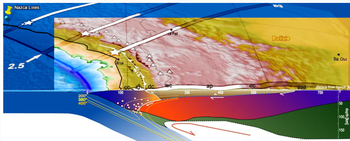
E5. Conductivity
Keywords: resistivity, Electric conductivity, Magnetotelluric conditions
Generalities
Geophysical investigations carried out during the last two decades in the Central Andes have revealed a complex crust and upper mantle structure, with strong variations along the Cordillera axis as well as in the transition zones from the forearc to the backarc. Several magnetotelluric (MT) studies in the southern Central Andes comprising traverses in Argentina, Bolivia and Chile have resulted in models of the crust and upper mantle electrical structure that can be directly related to the active tectonic and volcanic processes in the area. Schwarz et al. (1984, 1994), Schwarz & Krüger (1997) and Echternacht et al. (1997) found several zones of high electrical conductivity reaching total conductances of 20 000±30 000 S (Siemens).
Beneath the Bolivian Altiplano the total conductance is over 10 000 S, yet the Subandean ranges and the Chaco lowland plains of southern Bolivia and northwestern Argentina have no particularly high crustal conductivities (Krüger 1994; Schwarz et al. 1994). High-conductivity zones have also been encountered in the provinces of Tucuman and Santiago del Estero (NW Argentina), reaching a total conductance of about 30 000 S; in this case, the zone of high conductance lies within a seismic activity gap and is clearly associated with surface geothermal activity (Febrer et al. 1981; Baldis et al. 1983; MunÄoz et al. 1992)
Ground composition
The conductivity of the rocks is important, the majority of the metamorphic rocks of the earth's crust are most of the time of good insulators. Except for the sulphide ores which are relatively conductive, and the only mineral oxide which shows an appreciable electronic conductivity is magnetite (Fe3O4).
Despite the fact that we considerably lack of informations (measurements) the site of Nazca is an important source of magnetite in association with copper sulphides.
Magnetotelluric studies
The following studies can hardly be linked to the Nazca site and because the Magnetotelluric conditions can change very quickly on short distances (few kilometers).
Electrical conductivity anomalies (high and low) in the Central Andes - interpretation and open problems H. Brasse, FU Berlin
Magnetotelluric (MT) investigations revealed several zones of enhanced electrical conductivity at different depth levels in the Central Andean crust and upper mantle. While some of these zones are well studied and believed to be explainable in terms of their petrophysical and tectonic behavior, there remain manifold open questions in understanding their detailed geometry and their relation to other geophysical parameters and geological/tectonic processes.
- In the Coastal Cordillerra anomalies in the middle crust superimpose and even dominate the coast effect (originating from the highly conducting Pacific Ocean). Are these anomalies related to the Atacama fault system; do they hint at graphite depletion on shear zones or increased hydraulic routing in these crustal levels?
- EW-striking anomalies were recognized in the Forearc and display a certain correlation with aeromagnetic features. Does this indicate a prolongation of prominent fault zones like the El Toro-Calama lineament towards the west?
- A highly conductive zone (HCZ) characterizes the run of the Falla Oeste in the Precordillera in the upper and lower (!) crust. Beyond the more suggestive interpretation by ore deposits, other mechanisms must be taken into account to explain the deep seated HCZ.
- The magmatic arc hosts the most prominent HCZ in the Central Andes at depths > 20 km. It correlates with a seismic low velocity zone, high seismic absorption and a gravity low and may be explained by vast amounts of partial melts (cf. contribution by F. Schilling). However, the anomaly strikes obliquely to the Western Cordillera and vanishes in the north at 20°S. Is there thus a correlation to the flattening of subduction towards the south and/or does it indicate recent cooling of the lower crust in the region of the Pica gap?
- Early models of a backarc conductor below the Altiplano suggest a ramp-like geometry (ascending towards the east) and may hint at the overthrusting of the Andean crust over the Brazilian craton. This important topic will be addressed during the ANCORP MT experiment.
An ascending HCZ - interpreted as a rise of the electrical asthenosphere - was modelled below the Eastern Cordillera in NW Argentina. How does this structure - also evident from seismological observations - relate to the Puna volcanism and/or the development of the Salta Rift?
Geology
G1. Ore ressources
Iron-Oxyde, Copper and Gold
Nazca is located near the southern end of a belt approximately 70 km wide and stretching 400 km along the Peruvian coast from Lima to south of Chala. This belt hosts numerous mineral occurrences grouped together under the general heading of Iron-Oxide Copper-Gold (IOCG) deposits. The belt consists of a series of Precambrian gneisses and schists overlain by subordinate Palaeozoic sediments and volcanics and by more extensive volcano-sedimentary rocks of Triassic-Jurassic age.
Intersection of the northeast trending Nazca Ridge and the continental margin, coinciding with the southern limit of the major Peruvian flat-slab domain and the northern limit of the Central Volcanic Zone makes this zone very rich in minerals.
Nearest Mines
The Mina Justa Copper Prospect is the largest new discovery of an Iron Oxide Copper Gold (“IOCG”) deposit in Latin America in the last 10 years. The town of Nazca, on the Pan American highway, is located approximately 35 km to the north-northeast. The Marcona Project consists of five Fe-oxide Cu (Ag-Au) prospects that are part of the large iron-oxide rich hydrothermal system associated with the Marcona Fe (+/- Cu, Au, Ag, Zn, Co) deposits located within a few kilometres.
Marcona mine is worked at "open sky": it do not require galleries, the seams going up to the surface. Notice that copper-bearing sulfides which are found at Mina Justa are accompanied by varying amounts of magnetite and actinolite, (copper grade is generally proportional to the amount of copper sulphides, which in turn is proportional to the amount of magnetite).
G2. Seismology
An area geologically very active.
Seisms in Peru regularly destroy constructions and are making thousands of victims. At the the vertical of Nazca, the depth of the Wadati-Benioff zone is approximatively of 70km.


Archaeology
A1. Construction
The layouts correspond to cleared zones:
A2. Metalworking
Does Nazcans were able to mine copper and gold?.
This question remains difficult to resolve since an absence of elements. In the context of the time it appears that is not at all impossible: gold sheets were found at the Ugly one which were installed to some 150 km in the north of Nazca, and which lived at one contemporary time.
resources:
- “Recent archaeological finds suggest that South Americans were obtaining gold from to place now deposits and mining and smelting oxidized copper in exchange Peru butt 1500 B.C”
- Caley [1953] made achéo-metallurgical studies on “Ugly” the pre-INCA Indians of Peru and showed that they melted copper starting from the ore of copper sulfide as of the year 200 ap JC.
- Shimada, Izumi, Stephen Epstein and Alan K. Craig; “Batán Large: In Prehistoric Metallurgical Center in Peru,”
- Recent archeological fieldwork one the north coast of Peru permits has preliminary rebuilding of has prill-extraction copper and copper alloy smelting process heretofore undocumented in the New World. The process was applied one has broad scale during the late pre-Hispanic period. This study provides strong support for the claim that central Andean metallurgy constituted one of the major independent metallurgical traditions of the world., Science, May 1982.
- R.L. Burger, R.B. Gordon [1998], “Of the artifacts of gold and copper dated in context with carbon-14 with 3120-3020 years before the present (~1410 to 1090 front JC) found in excavation made in Mina Perdida, Lurín Valley. They show that the craftsmen could transform native metals into sheets, sometimes with annealings. They covered with the copper artifacts by sheets with gold”, Science, Nov 6, 1998. Article of the university of Yale
Mythology and beliefs in association with the geoglyphs
R1. Mythology
- Layouts of the animals
- Layouts of the lines
- Centers of the lines
Conclusion?
How to prove this assumption? Perhaps in trying to measure directly the comportment of the MT field ?
References
- ↑ J. Reinhard, 'The Nazca Lines', 5th edition, Lima, 1993






